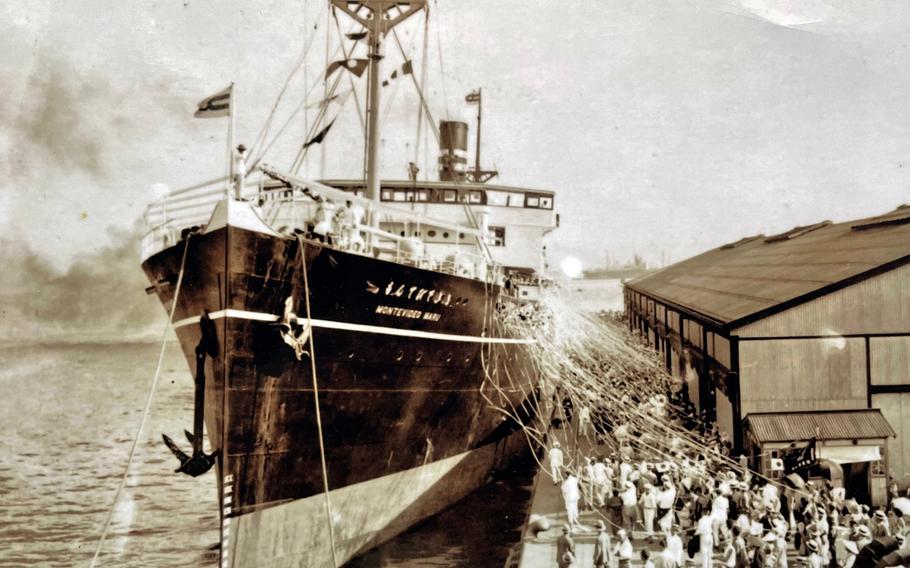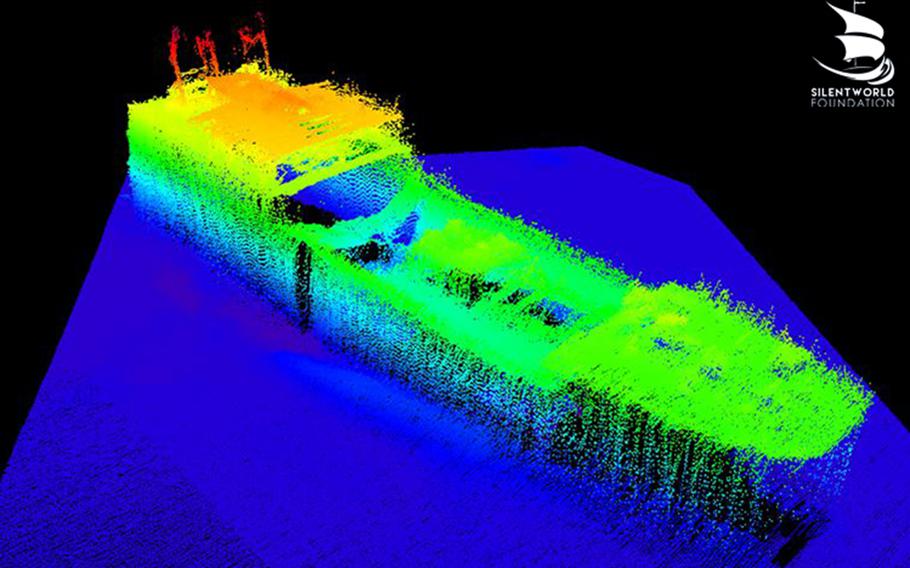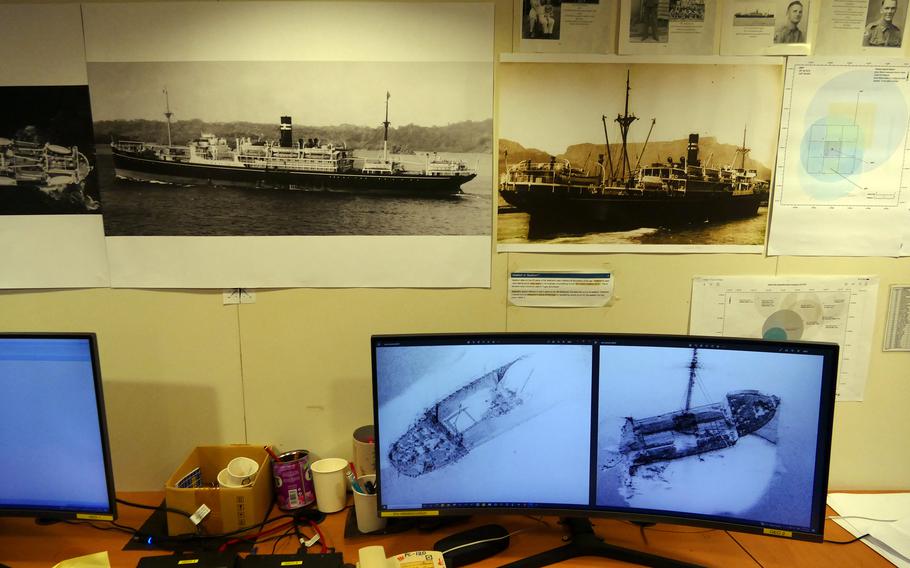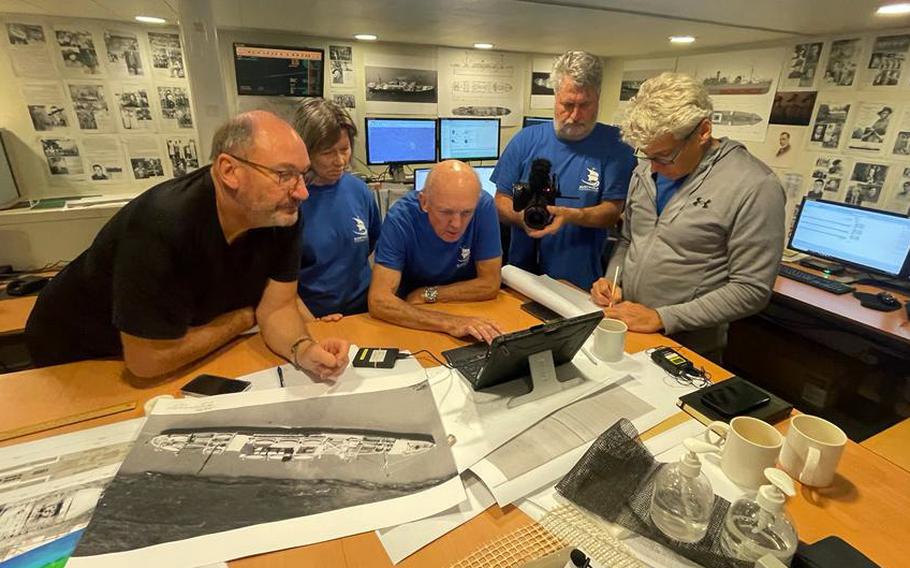
An undated photo of the SS Montevideo Maru leaving port. (Silentworld Foundation)
Explorers have discovered the wreck of a World War II-era Japanese ship that carried more than 1,000 prisoners of war off the coast of the Philippines, solving an 80-year-old mystery, the expedition announced Saturday.
Over the course of 16 days, the expedition tracked down the wreck of the SS Montevideo Maru off Luzon at a depth of more than 13,000 feet — deeper than the Titanic — according to a news release from the Sydney-based Silentworld Foundation.
The ship’s final resting place was unknown since it sank on July 1, 1942, after the American submarine USS Sturgeon, unaware that the ship was carrying prisoners, fired four torpedoes at Montevideo Maru. Two torpedoes struck the ship, and it sank just 11 minutes after impact, according to the Australian War Memorial website.
“The discovery of the Montevideo Maru closes a terrible chapter in Australian military and maritime history,” said John Mullen, director of Silentworld, in the release. “Today, by finding the vessel, we hope to bring closure to the many families devastated by this terrible disaster.”

A 3D image of the SS Montevideo Maru's wreck, which was discovered Saturday, April 22, 2023. (Silentworld Foundation)
Among the prisoners were at least 850 Australian service members and 210 civilians from 14 countries. The ship’s destruction marked the largest maritime wartime loss for Australia, according to the release.
Vessels like the Montevideo Maru were known as “hell ships” because prisoners were often crammed into cargo holds during long journeys with little air, food or water.
The expedition was a joint venture between Silentworld, the Dutch deep-sea survey company Fugro and Australia’s Defence Department.
Tim Brown, a retired Australian navy commodore who spent the past 18 months fundraising and helping plan the expedition, described the discovery as “unreal.” He said he didn’t expect the outpouring of international attention.
“I think it’s taken everybody by surprise,” he told Stars and Stripes by phone Monday from the deck of the oceanographic vessel Fugro Equator. “It’s really just such an honor and a privilege to play a small part in it overall.”
While the project itself had been in the works for five years, the search began on April 6 in the South China Sea about 68 miles from Luzon. After using ship records and oceanographic charts to narrow the search radius to around 5 ½ miles, the crew of the Fugro Equator used sonar-equipped and autonomous underwater vehicles to search for wreckage.
“We went back and started on the most probable position and basically ran a racetrack back and forth, uncovering the area,” Brown said. “Lucky for us, Mother Nature made the bottom here very flat, without any geological features whatsoever, so anything on this ship would really stand out.”
The crew found the Montevideo Maru just 12 days into their search, but confirmation of the vessel took several more days. Brown noted the timing of the discovery came just three days before Anzac Day, a national holiday in Australia and New Zealand that honors the members of their armed forces killed in military operations.

A comparison of images of the SS Montevideo Maru aboard the oceanographic ship Fugro Equator, whcih discovered the wreck on Saturday, April 22, 2023. (Silentworld Foundation)
“The story, not just of the Montevideo Maru and the loss and tragedy that surrounds it, but the story of the war in the Pacific is a story that should never be forgotten,” Brown said. “So, we can learn the lessons of it and hope that it never happens again.”
The wreck will remain undisturbed, and no artifacts or human remains will be removed out of respect for the families, according to the release, but the site will be recorded for research purposes.
Following the expedition’s discovery, Brown said there has been an “outpouring of grief and relief and gratitude,” both from Australia and internationally. Norway, for example, had around 19 people aboard the ship, and the country has contacted the crew to express thanks.
“There’s been a response from people in countries all over the world — in most cases direct descendants are no longer alive,” he said, “but it’s been the grandchildren and great grandchildren, nieces and nephews, that have heard the stories and felt the pain and anguish from their parents.”
Japan, which provided its own research to assist the expedition, has also expressed appreciation for the discovery, Brown said.
“There’s been many messages sent to Mullen, the head of the expedition, officially from the Japanese side talking about their gratitude,” he said. I think that things like this help heal wounds together.”

Members of the Silentworld Foundation review historical records and images of the SS Montevideo Maru in this undated photo. (Silentworld Foundation)